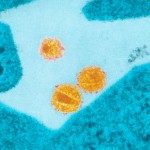Lien vers Pubmed [PMID] – 20522787
Am. J. Respir. Crit. Care Med. 2010 Sep;182(6):774-83
RATIONALE: Pulmonary fibrosis is a devastating as yet untreatable disease. We previously investigated the endogenous mediators released on lung injury and showed that uric acid is a danger signal activating Nod-like receptor family, pyrin domain containing 3 (NLRP3) inflammasome in lung inflammation and fibrosis (Gasse et al., Am J Respir Crit Care Med 2009;179:903-913).
OBJECTIVES: Here we address the role of extracellular adenosine triphosphate (eATP) in pulmonary inflammation and fibrosis.
METHODS: ATP was quantified in bronchoalveolar lavage fluid (BALF) of control subjects and patients with idiopathic pulmonary fibrosis. The contribution of eATP as a danger signal was assessed in a murine model of lung fibrosis induced by airway-administered bleomycin (BLM), an intercalating agent that causes DNA strand breaks.
MEASUREMENTS AND MAIN RESULTS: Fibrotic patients have elevated ATP content in BALF in comparison with control individuals. In mice, we report an early increase in eATP levels in BALF on BLM administration. Modulation of eATP levels with the ATP-degrading enzyme apyrase greatly reduced BLM-induced inflammatory cell recruitment, lung IL-1β, and tissue inhibitor of metalloproteinase (TIMP)-1 production, while administration of ATP-γS, a stable ATP derivative, enhanced inflammation. P2X(7) receptor-deficient mice presented dramatically reduced lung inflammation, with reduced fibrosis markers such as lung collagen content and matrix-remodeling proteins TIMP-1 and matrix metalloproteinase-9. The acute inflammation depends on a functional pannexin-1 hemichannel protein. In vitro, ATP is released by pulmonary epithelial cells on BLM-induced stress and this is partly dependent on the presence of functional P2X(7) receptor and pannexin-1 hemichannel.
CONCLUSIONS: ATP released from BLM-injured lung cells constitutes a major endogenous danger signal that engages the P2X(7) receptor/pannexin-1 axis, leading to IL-1β maturation and lung fibrosis.
